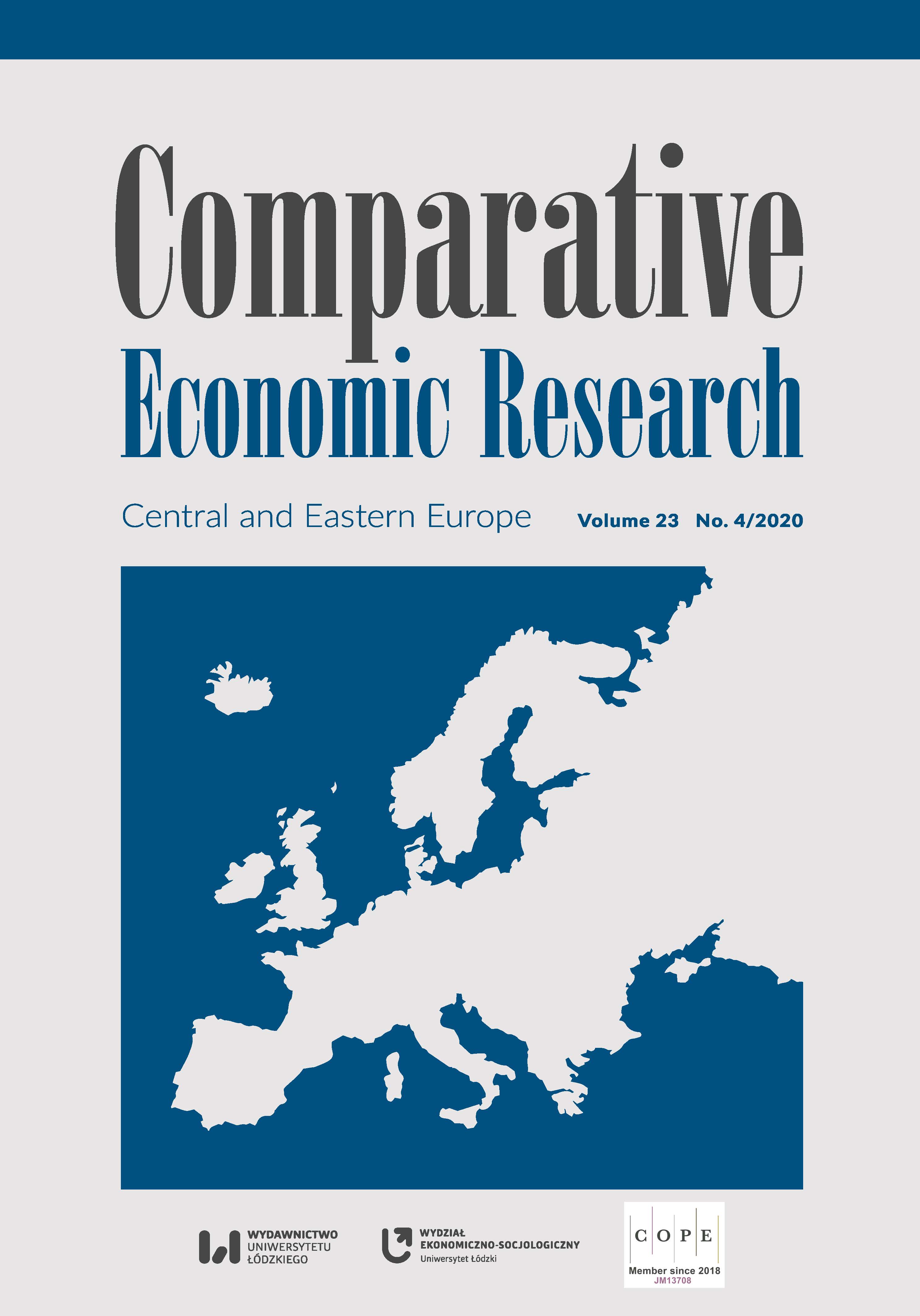Określenie przestrzennych wzorców determinant innowacji w regionalnych wynikach gospodarczych
DOI:
https://doi.org/10.18778/1508-2008.23.29Słowa kluczowe:
innowacjność regionów, wzorce innowacji, przestrzenne rozprzestrzenianie, czynniki wspólne, przestrzenny ekonometryczny model panelowyAbstrakt
Niniejszy artykuł analizuje rolę czynników innowacyjności w rozwoju regionalnym 261 regionów UE w latach 2009–2012. Analiza przestrzenna wskazała, że regionalna innowacyjność, a dalej rozwój regionalny, zależą nie tylko od położenia geograficznego regionu, ale i jego sąsiadów. Pociąga to za sobą szczególnie poważne konsekwencje dla Europy Środkowo‑Wschodniej. Za pomocą przestrzennego modelu panelowego Durbina ze stałymi efektami grupowymi (dla krajów), oceniliśmy wpływ czynników innowacji i ich przestrzennych odpowiedników na regionalne wyniki ekonomiczne. Pokazał on, że regiony czerpią korzyści ekonomiczne ze swoich efektów lokalizacyjnych pod względem kapitału społecznego, jednak w przypadku wydatków na badania i rozwój ujawniono efekt konkurencji między regionami.
Pobrania
Bibliografia
Anselin, L. (1998), Spatial Econometrics: Methods and Models, Kluwer, Dordrecht.
Google Scholar
Anselin, L., Le Gallo, J., Jayet, H. (2008), Spatial panel econometrics, [in:] L. Mátyás, P. Sevestre (eds.) The econometrics of panel data, fundamentals and recent developments in theory and practice, 3rd ed., Kluwer, Dordrecht. https://doi.org/10.1007/978-3-540-75892-1_19
Google Scholar
DOI: https://doi.org/10.1007/978-3-540-75892-1_19
Anselin, L., Varga, A., Acs, Z. (1997), Local Geographic Spillovers between University Research and High Technology Innovations, “Journal of Urban Economics”, 42 (3), pp. 422–448. https://doi.org/10.1006/juec.1997.2032
Google Scholar
DOI: https://doi.org/10.1006/juec.1997.2032
Bilbao-Osorio, B., Rodríguez-Pose, A. (2004), From R&D to Innovation and Economic Growth in the EU, “Growth and Change”, 35 (4), pp. 434–455. https://doi.org/10.1111/j.1468-2257.2004.00256.x
Google Scholar
DOI: https://doi.org/10.1111/j.1468-2257.2004.00256.x
Boschma, R. (2005), Proximity and innovation – a critical assessment, “Regional Studies”, 39 (1), pp. 61–74. https://doi.org/10.1080/0034340052000320887
Google Scholar
DOI: https://doi.org/10.1080/0034340052000320887
Brouwer, E., Kleinknecht, A. (1999), Innovative output, and a firm’s propensity to patent. An exploration of CIS micro data, “Research Policy”, 28 (6), pp. 615–624. https://doi.org/10.1016/S0048-7333(99)00003-7
Google Scholar
DOI: https://doi.org/10.1016/S0048-7333(99)00003-7
Cabrer-Borrás, B., Serran-Domingo, G. (2007), Innovation and R&D spillover effects in Spanish regions: A spatial approach, “Research Policy”, 36, pp. 1357–1371. https://doi.org/10.1016/j.respol.2007.04.012
Google Scholar
DOI: https://doi.org/10.1016/j.respol.2007.04.012
Caragliu, A., Nijkamp, P. (2012), The impact of regional absorptive capacity on spatial knowledge spillovers: the Cohen and Levinthal model revisited, “Applied Economics”, 44, pp. 1363–1374. https://doi.org/10.1080/00036846.2010.539549
Google Scholar
DOI: https://doi.org/10.1080/00036846.2010.539549
Cliff, A.D., Ord, J.K. (1981), Spatial processes: models and applications, Taylor & Francis, London.
Google Scholar
Corrado, C., Haskel J., Jona-Lasinio, C. (2017), Knowledge Spillovers, ICT and Productivity Growth, “Oxford Bulletin of Economics and Statistics”, 79 (4), pp. 592–618. https://doi.org/10.1111/obes.12171
Google Scholar
DOI: https://doi.org/10.1111/obes.12171
Corrado, C., Hulten, Ch., Sichel, D. (2009), Intangible capital and U.S. economic growth, “The Review of Income and Wealth”, 55 (3), pp. 661–685. https://doi.org/10.1111/j.1475-4991.2009.00343.x
Google Scholar
DOI: https://doi.org/10.1111/j.1475-4991.2009.00343.x
Crescenzi, R., Rodrígue-Pose, A., Storper, M. (2007), The territorial dynamics of innovation: a Europe – United States comparative analysis, “Journal of Economic Geography”, 7 (6), pp. 673–709. https://doi.org/10.1093/jeg/lbm030
Google Scholar
DOI: https://doi.org/10.1093/jeg/lbm030
Dominicis, L. de, Florax, R.J.G.M., Groot, H.L.F. de (2013), Regional clusters of innovative activity in Europe: are social capital and geographical proximity key determinants?, “Applied Economics”, 45 (17), pp. 2325–2335. https://doi.org/10.1080/00036846.2012.663474
Google Scholar
DOI: https://doi.org/10.1080/00036846.2012.663474
Educational attainment statistics. http://ec.europa.eu/eurostat/statistics-explained/index.php/Educational_attainment_statistics (accessed: 23.02.2020).
Google Scholar
Elhorst, J.P. (2014), Spatial Panel Models, [in:] M. Fischer, P. Nijkamp (eds.) Handbook of Regional Science, Berlin, Springer. https://doi.org/10.1007/978-3-642-23430-9_86
Google Scholar
DOI: https://doi.org/10.1007/978-3-642-23430-9_86
Elhorst, J.P., Gross M., Tereanu E. (2018), Spillovers in space and time: where spatial econometrics and Global VAR models meet, European, Central Bank, Frankfurt, Working Paper Series, No. 2134.
Google Scholar
DOI: https://doi.org/10.2139/ssrn.3134525
European Innovation Scoreboard 2016. https://op.europa.eu/en/publication-detail/-/publication/693eaaba-de16-11e6-ad7c-01aa75ed71a1/language-en/format-PDF/source-31233711 (accessed: 23.02.2020).
Google Scholar
Eurostat Regional Database. https://ec.europa.eu/eurostat/web/regions/data/database (accessed: 23.02.2020).
Google Scholar
Frascati Manual (2002). https://www.oecd-ilibrary.org/science-and-technology/frascati-manual-2002_9789264199040-en (accessed: 23.02.2020).
Google Scholar
Global Innovation Index 2016 report. http://www.wipo.int/edocs/pubdocs/en/wipo_pub_gii_2016.pdf (accessed: 23.02.2020).
Google Scholar
Global Innovation Index 2017 report. https://www.globalinnovationindex.org/userfiles/file/reportpdf/gii-full-report-2017.pdf (accessed: 23.02.2020).
Google Scholar
Global Innovation Index 2018 report. https://www.globalinnovationindex.org/userfiles/file/reportpdf/gii_2018-report-new.pdf (accessed: 23.02.2020).
Google Scholar
Global Innovation Index 2019 report. https://www.globalinnovationindex.org/userfiles/file/reportpdf/GII2019-keyfinding-E-Web3.pdf (accessed: 23.02.2020).
Google Scholar
Gonçalves, E., Almaida, E.S. (2009), Innovation and Spatial Knowledge Spillovers: Evidence from Brazilian Patent Data, “Regional Studies”, 43 (4), pp. 513–528. https://doi.org/10.1080/00343400701874131
Google Scholar
DOI: https://doi.org/10.1080/00343400701874131
Granovetter, M. (2005), The impact of social structure on economic outcomes, “Journal of Economic Perspectives”, 19 (1), pp. 33–50. https://doi.org/10.1257/0895330053147958
Google Scholar
DOI: https://doi.org/10.1257/0895330053147958
Griliches, Z. (1979), Issues in assessing the contribution of research and development to productivity growth, “Bell Journal of Economics”, 10 (1), pp. 92–116. https://doi.org/10.2307/3003321
Google Scholar
DOI: https://doi.org/10.2307/3003321
Halleck, V.S., Elhorst J.P. (2016), A regional unemployment model simultaneously accounting for serial dynamics, spatial dependence and common factors, “Regional Science and Urban Economics”, 60, pp. 85–95. https://doi.org/10.1016/j.regsciurbeco.2016.07.002
Google Scholar
DOI: https://doi.org/10.1016/j.regsciurbeco.2016.07.002
Jaffe, A.B. (1989), Real effects of academic research, “American Economic Review”, 79 (5), pp. 957–970.
Google Scholar
Kelejian, H.H., Prucha, I.R. (1998), A Generalised Spatial Two-Stage Least Squares Procedure for Estimating a Spatial Autoregressive Model with Autoregressive Disturbances, “The Journal of Real Estate Finance and Economics”, 17 (1), pp. 99–121.
Google Scholar
DOI: https://doi.org/10.1023/A:1007707430416
Kelejian, H.H., Prucha, I.R. (2010), Specification and estimation of spatial autoregressive models with autoregressive and heteroskedastic disturbances, “Journal of Econometrics”, 157 (1), pp. 53–67. https://doi.org/10.1016/j.jeconom.2009.10.025
Google Scholar
DOI: https://doi.org/10.1016/j.jeconom.2009.10.025
LeSage, J., Pace, R.K. (2009), Introduction to Spatial Econometrics, Taylor & Francis Group, New York. https://doi.org/10.1201/9781420064254
Google Scholar
DOI: https://doi.org/10.1201/9781420064254
Moran, P.A.P. (1948), The Interpretation of Statistical Maps, “Journal of the Royal Statistical Society”, Series B (Methodological), 10 (2), pp. 243–251. https://doi.org/10.1111/j.2517-6161.1948.tb00012.x
Google Scholar
DOI: https://doi.org/10.1111/j.2517-6161.1948.tb00012.x
Olejnik, J., Olejnik, A. (2020), QML estimation with non summable weight matrices, “Journal of Geographical Systems”, 22, pp. 469–495. https://doi.org/10.1007/s10109-020-00326-2
Google Scholar
DOI: https://doi.org/10.1007/s10109-020-00326-2
Ord, K. (1975), Estimation Methods for Models of Spatial Interaction, “Journal of the American Statistical Association”, 70, pp. 120–126. https://doi.org/10.1080/01621459.1975.10480272
Google Scholar
DOI: https://doi.org/10.1080/01621459.1975.10480272
Regional Innovation Scoreboard 2016 report. https://op.europa.eu/en/publication-detail/-/publication/693eaaba-de16-11e6-ad7c-01aa75ed71a1/language-en/format-PDF/source-31233711 (accessed: 23.02.2020).
Google Scholar
Regional Innovation Scoreboard 2017 report. https://op.europa.eu/en/publication-detail/-/publication/ce38bc9d-5562-11e7-a5ca-01aa75ed71a1/language-en/format-PDF/source-99532255 (accessed: 23.02.2020).
Google Scholar
Regional Innovation Scoreboard 2019 report. https://ec.europa.eu/growth/sites/growth/files/ris2019.pdf (accessed: 23.02.2020)
Google Scholar
Shi, W., Lee, L.F. (2017), Spatial dynamic panel data model with interactive fixed effects, “Journal of Econometrics”, 197, pp. 323–347. https://doi.org/10.1016/j.jeconom.2016.12.001
Google Scholar
DOI: https://doi.org/10.1016/j.jeconom.2016.12.001
Pobrania
Opublikowane
Jak cytować
Numer
Dział
Licencja

Utwór dostępny jest na licencji Creative Commons Uznanie autorstwa – Użycie niekomercyjne – Bez utworów zależnych 4.0 Międzynarodowe.











